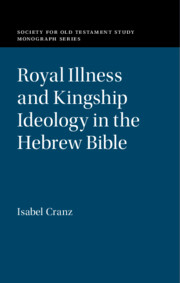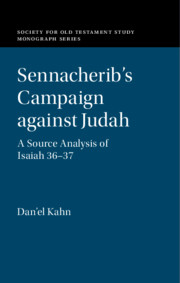12 results in Society for Old Testament Study Monographs

The Book of Amos and its Audiences
- Prophecy, Poetry, and Rhetoric
-
- Published online:
- 08 June 2023
- Print publication:
- 22 June 2023

The Death Wish in the Hebrew Bible
- Rhetorical Strategies for Survival
-
- Published online:
- 10 September 2021
- Print publication:
- 23 September 2021

Israel and Judah Redefined
- Migration, Trauma, and Empire in the Sixth Century BCE
-
- Published online:
- 05 August 2021
- Print publication:
- 12 August 2021

Life, Land, and Elijah in the Book of Kings
-
- Published online:
- 19 November 2020
- Print publication:
- 10 December 2020

Royal Illness and Kingship Ideology in the Hebrew Bible
-
- Published online:
- 19 November 2020
- Print publication:
- 22 October 2020

Divine Aggression in Psalms and Inscriptions
- Vengeful Gods and Loyal Kings
-
- Published online:
- 16 October 2020
- Print publication:
- 15 October 2020

Sennacherib's Campaign against Judah
- A Source Analysis of Isaiah 36-37
-
- Published online:
- 29 September 2020
- Print publication:
- 27 August 2020

Cognitive Science and Ancient Israelite Religion
- New Perspectives on Texts, Artifacts, and Culture
-
- Published online:
- 17 September 2020
- Print publication:
- 08 October 2020

YHWH and Israel in the Book of Judges
- An Object – Relations Analysis
-
- Published online:
- 12 December 2018
- Print publication:
- 06 December 2018

Marriage by Capture in the Book of Judges
- An Anthropological Approach
-
- Published online:
- 30 March 2017
- Print publication:
- 24 March 2017

The Way of the Wilderness
- A Geographical Study of the Wilderness Itineraries in the Old Testament
-
- Published online:
- 04 August 2010
- Print publication:
- 10 May 1979

The Heavenly Counsellor in Isaiah xl 13-14
- A Study of the Sources of the Theology of Deutero-Isaiah
-
- Published online:
- 08 March 2010
- Print publication:
- 02 May 1971

